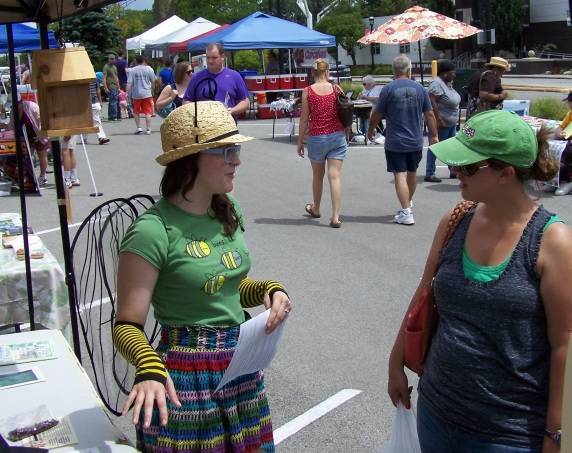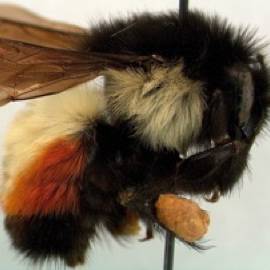
It’s a chilly morning on the first Saturday in June, which means I’m in my bee costume at the Urbana Market at the Square: black and yellow tights with matching fingerless gloves, a rainbow skirt with a honeycomb pattern, and black pipe cleaner antennae. The children seem to enjoy my outfit … the adults, not quite as much. The adults that do approach my booth mostly come to tell me how scared of bees they are, or to ask how to kill the ones that are chewing holes in their deck (which are carpenter bees, by the way). I’ve been at the farmer’s market every Saturday in June for the past three years to advertise for National Pollinator Week. Every June, I begin my metamorphosis from Michelle Duennes, graduate student in entomology at the University of Illinois, to Polly Nator, defender of bees (Polly Nator is not just a champion of bee justice; she’s also a hard-hitting rollergirl for the Twin City Derby Girls).
Why do I do this, you ask? Because I love bees. Let me repeat myself: I LOVE BEES. More specifically, I love bumble bees. I love everything about them. I love their extraordinary social behavior. I love how they can fly when there is still snow on the ground because they can make their own body heat. I love all of the beautiful colors they have around the world. Another reason I love them, and a reason you should love them, too, is that they are vitally important to our food system. By collecting pollen and nectar from flowers to eat, they in turn transfer pollen between plants, thereby fertilizing them so that they can produce fruit and seeds. Without the crucial pollination that bumble bees provide, we wouldn’t have peppers, tomatoes, eggplants, melons, and lots of other fruits, vegetables, and nuts. If you visited Common Ground Food Co-op during National Pollinator Week this year, you saw numerous signs indicating all of the foods that rely on pollinators. But the real reason I try so hard to raise awareness about bumble bees is because they are in trouble, and part of the reason they are in trouble is our fault.
You’ve probably heard about all of the problems the honey bee has been having, but you might not know that many species of bumble bees worldwide are also in trouble. Many factors have been implicated in these die-offs, including habitat destruction, the over-use of pesticides, the spread of infectious diseases, as well as the introduction of non-native bees. Bumble bee species are introduced into non-native areas through their commercial trade for crop pollination, and this can cause a whole suite of problems for the native bees that live there. The most recent news about this has been about how the European bumble bee Bombus terrestris has seriously been hurting the big beautiful South American bumble bee Bombus dahlbomii. In 1997 B. terrestris was introduced into Chile from Europe to pollinate agricultural crops, and soon after people starting seeing less and less of B. dahlbomii, and researchers in Chile suspect that a nasty parasite brought over by B. terrestis has been killing off B. dalhbomii. My advisor, Dr. Sydney Cameron, recently travelled to Chile to meet with these researchers and said the numbers of B. terrestris you would see in the cities were astounding. She likened their numbers to a swarm of honey bees or ants. They are completely taking over.
Non-native bees can hurt native bee populations by not only spreading disease, but also by hybridizing and mating with native species. Here in Illinois, we tend to think of hybrids as a good thing; corn hybrids are better at defending themselves from pests and disease. But hybridization can have serious consequences (think “killer bees”). When hybridization or mating happens between native bees and bees that were never supposed to be there in the first place, it can decimate the native population. In Japan, Bombus terrestris is causing declines in the native species Bombus hypocrita. The males of B. terrestris will mate with wild B. hypocrita queens (the reproductive females), but won’t actually get them pregnant. Because most bumble bee queens mate only once in their lifetime, mating with B. terrestis has caused serious declines in B. hypocrita. Bombus terrestris has also become naturalized in the wild in Korea, and is capable of hybridizing and reproducing with the native bee B. ignitus. This “genetic pollution” of the native species by the invasive bees has the potential to push the native species to extinction.
Mating between commercial bees and native bees can even be a problem when the native species is being used for pollination. Researchers in Europe have found that commercial colonies of B. terrestris that were being kept in greenhouses in Poland to pollinate tomatoes were escaping from the greenhouses and mating and reproducing with the wild B. terrestris living just outside of the greenhouses. The commercial bees are very inbred because they are reared in laboratories and are constantly being mated with themselves to keep the colonies of bees going. The same thing happens to bees as does to people when they are highly inbred; they can develop genetic disorders and also become more susceptible to disease. When those commercial bees mate with native bees, they can give their weak and inbred versions of genes to the wild bees. This same situation is going on between farmed and wild salmon. We could see a similar situation like this happen with Bombus impatiens, a bumble bee native to Illinois and the Eastern U.S. that is extensively used for greenhouse pollination.
How do we know commercial bees are mating with native bees, and why are bees that are different species able to mate and hybridize with each other? This is where knowledge of their evolutionary history becomes very important. These species are capable of hybridizing because they are very closely related to each other; that is, they shared a common ancestor not so long ago. Generally, the shorter the time since two species shared a common ancestor, the higher the chance is that they can mate and hybridize with each other. The bees’ DNA code can teach us the relationship between populations and species. In my research, I take a piece of a gene from each of the species I want to study and I line up the pieces of that gene next to each other to look for differences. I use the differences to build the evolutionary relationships among those species. In my work this DNA information revealed the evolutionary history of a Mexican bumble bee species, Bombus ephippiatus. This species is currently being brought into laboratories and reared so that it can be commercially available for greenhouse pollination throughout Central America.
This species, Bombus ephippiatus, lives throughout Mexico and Central America. Across its range it possesses a variety of different colors. In the picture, you see the beautiful red, yellow, and black form that lives throughout Mexico, but in Guatemala, Honduras, and Nicaragua it is only yellow and black, and in Costa Rica the queens are bright yellow and orange with no black on them at all. All of this diversity in color has made some bumble bee researchers question whether or not it is a single species. I am exploring that question by looking at their DNA. The research I’ve done so far shows that B. ephippiatus is at least four different species. One of them lives from northern Mexico to the northern edge of the Mexican state of Chiapas. Two others live together from Chiapas, Mexico to Honduras. The final group lives in Costa Rica. Data I’ve collected most recently suggest that even more diversity might exist within B. ephippiatus.
 These species that I’ve identified within B. ephippiatus are much more closely related to each other than the species I mentioned in Japan and Korea that have been hybridizing and mating. If the species from northern Mexico was brought into Guatemala for greenhouse pollination, the chance of it escaping and hybridizing with the native species there is very high. Also, if B. ephippiatus is reared extensively in the lab like B. terrestris, those lab colonies could become inbred like B. terrestris and could spread inbred traits into the healthy wild populations. It is my hope that by communicating this knowledge to the commercial bumble bee companies in Mexico they will ensure the safe trafficking of these bees throughout Mexico and Central America. Incorporating the implications of my findings with their business practices could make these Mexican pollinator companies a role model for other agro-businesses worldwide.
These species that I’ve identified within B. ephippiatus are much more closely related to each other than the species I mentioned in Japan and Korea that have been hybridizing and mating. If the species from northern Mexico was brought into Guatemala for greenhouse pollination, the chance of it escaping and hybridizing with the native species there is very high. Also, if B. ephippiatus is reared extensively in the lab like B. terrestris, those lab colonies could become inbred like B. terrestris and could spread inbred traits into the healthy wild populations. It is my hope that by communicating this knowledge to the commercial bumble bee companies in Mexico they will ensure the safe trafficking of these bees throughout Mexico and Central America. Incorporating the implications of my findings with their business practices could make these Mexican pollinator companies a role model for other agro-businesses worldwide.
Bumble bees are vitally important to our food system, and our actions can greatly affect whether they live or die. If you want to learn more about how you can help bees in our area, come visit me at the Urbana Market at the Square, and participate in all of the great events we’ll have for National Pollinator Week next June. I’ll be the girl in the bee costume.
Written by Michelle Duennes, PhD Candidate in Entomology, a.k.a. Polly Nator, skater for the Twin City Derby Girls.
To learn more, read about National Pollinator Week in Champaign-Urbana and Duennes career website.
~~*~~
Smile Politely is proud to introduce a new running series we are calling “Science Politely” that will feature the work of graduate students at the University of Illinois throughout November and December. Working in collaboration with the students in a graduate course in Integrative Biology, Science Politely is a collaboration aimed at bridging the gap between town and university, between scientist and citizen, and between research and culture.








